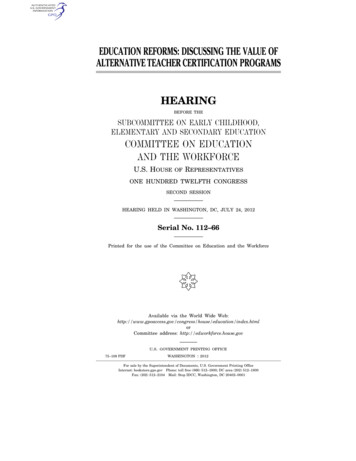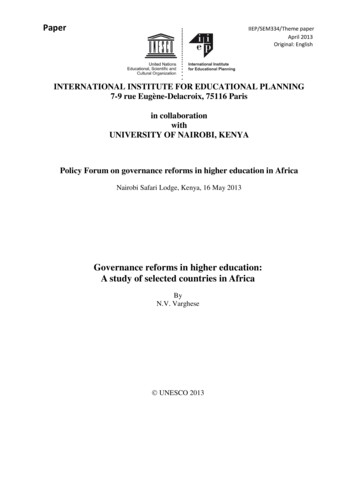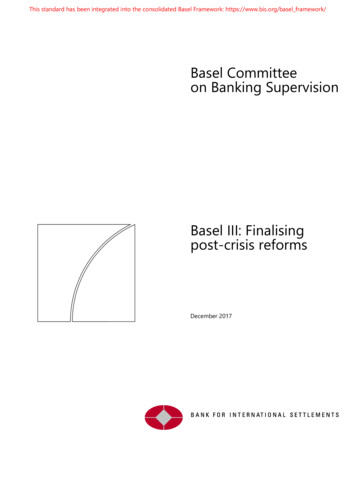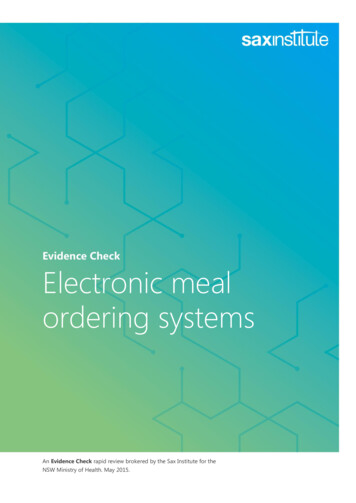
Transcription
EDUCATION REFORMS: DISCUSSING THE VALUE OFALTERNATIVE TEACHER CERTIFICATION PROGRAMSHEARINGBEFORE THESUBCOMMITTEE ON EARLY CHILDHOOD,ELEMENTARY AND SECONDARY EDUCATIONCOMMITTEE ON EDUCATIONAND THE WORKFORCEU.S. HOUSEOFREPRESENTATIVESONE HUNDRED TWELFTH CONGRESSSECOND SESSIONHEARING HELD IN WASHINGTON, DC, JULY 24, 2012Serial No. 112–66Printed for the use of the Committee on Education and the Workforce(Available via the World Wide ion/index.htmlorCommittee address: http://edworkforce.house.govU.S. GOVERNMENT PRINTING OFFICE75–109 PDFWASHINGTON:2012For sale by the Superintendent of Documents, U.S. Government Printing OfficeInternet: bookstore.gpo.gov Phone: toll free (866) 512–1800; DC area (202) 512–1800Fax: (202) 512–2104 Mail: Stop IDCC, Washington, DC 20402–0001
COMMITTEE ON EDUCATION AND THE WORKFORCEJOHN KLINE, Minnesota, ChairmanThomas E. Petri, WisconsinHoward P. ‘‘Buck’’ McKeon, CaliforniaJudy Biggert, IllinoisTodd Russell Platts, PennsylvaniaJoe Wilson, South CarolinaVirginia Foxx, North CarolinaBob Goodlatte, VirginiaDuncan Hunter, CaliforniaDavid P. Roe, TennesseeGlenn Thompson, PennsylvaniaTim Walberg, MichiganScott DesJarlais, TennesseeRichard L. Hanna, New YorkTodd Rokita, IndianaLarry Bucshon, IndianaTrey Gowdy, South CarolinaLou Barletta, PennsylvaniaKristi L. Noem, South DakotaMartha Roby, AlabamaJoseph J. Heck, NevadaDennis A. Ross, FloridaMike Kelly, PennsylvaniaGeorge Miller, California,Senior Democratic MemberDale E. Kildee, MichiganRobert E. Andrews, New JerseyRobert C. ‘‘Bobby’’ Scott, VirginiaLynn C. Woolsey, CaliforniaRubén Hinojosa, TexasCarolyn McCarthy, New YorkJohn F. Tierney, MassachusettsDennis J. Kucinich, OhioRush D. Holt, New JerseySusan A. Davis, CaliforniaRaúl M. Grijalva, ArizonaTimothy H. Bishop, New YorkDavid Loebsack, IowaMazie K. Hirono, HawaiiJason Altmire, PennsylvaniaMarcia L. Fudge, OhioBarrett Karr, Staff DirectorJody Calemine, Minority Staff DirectorSUBCOMMITTEE ON EARLY CHILDHOOD,ELEMENTARY AND SECONDARY EDUCATIONDUNCAN HUNTER, California, ChairmanJohn Kline, MinnesotaThomas E. Petri, WisconsinJudy Biggert, IllinoisTodd Russell Platts, PennsylvaniaVirginia Foxx, North CarolinaBob Goodlatte, VirginiaRichard L. Hanna, New YorkLou Barletta, PennsylvaniaKristi L. Noem, South DakotaMartha Roby, AlabamaMike Kelly, PennsylvaniaDale E. Kildee, MichiganRanking Minority MemberRobert C. ‘‘Bobby’’ Scott, VirginiaCarolyn McCarthy, New YorkRush D. Holt, New JerseySusan A. Davis, CaliforniaRaúl M. Grijalva, ArizonaMazie K. Hirono, HawaiiLynn C. Woolsey, CaliforniaMarcia L. Fudge, Ohio(II)
C O N T E N T SPageHearing held on July 24, 2012 .Statement of Members:Hunter, Hon. Duncan, Chairman, Subcommittee on Early Childhood, Elementary and Secondary Education .Prepared statement of .Kildee, Hon. Dale E., ranking member, Subcommittee on Early Childhood, Elementary and Secondary Education .Prepared statement of .Statement of Witnesses:Andrew, Seth, founder and superintendent, Democracy Prep PublicSchools .Prepared statement of .Banta, Maura, director of citizenship initiatives in education, IBM Corp. .Prepared statement of .Brown, Cynthia G., vice president for education policy, Center for American Progress Action Fund .Prepared statement of .Mulhern, Jennifer, vice president, TNTP .Prepared statement of .Additional Submissions:Mr. Andrew’s response to questions submitted for the record .Chairman Hunter:Questions submitted to Mr. Andrew .Questions submitted to Ms. Mulhern .Ms. Mulhern’s response to questions submitted for the record .(III)11334232691116185761606465
EDUCATION REFORMS: DISCUSSING THEVALUE OF ALTERNATIVE TEACHERCERTIFICATION PROGRAMSTuesday, July 24, 2012U.S. House of RepresentativesSubcommittee on Early Childhood,Elementary and Secondary EducationCommittee on Education and the WorkforceWashington, DCThe subcommittee met, pursuant to call, at 10:01 a.m., in room2175, Rayburn House Office Building, Hon. Duncan Hunter [chairman of the subcommittee] presiding.Present: Representatives Hunter, Kline, Petri, Biggert, Foxx,Noem, Roby, Kildee, Scott, Davis, and Woolsey.Staff present: Katherine Bathgate, Deputy Press Secretary;Adam Bennot, Press Assistant; James Bergeron, Director of Education and Human Services Policy; Casey Buboltz, Coalitions andMember Services Coordinator; Heather Couri, Deputy Director ofEducation and Human Services Policy; Lindsay Fryer, ProfessionalStaff Member; Krisann Pearce, General Counsel; Dan Shorts, Legislative Assistant; Alex Sollberger, Communications Director; LindaStevens, Chief Clerk/Assistant to the General Counsel; AlissaStrawcutter, Deputy Clerk; Brad Thomas, Senior Education PolicyAdvisor; Tylease Alli, Minority Clerk; Meg Benner, Minority Education Policy Advisor; Kelly Broughan, Minority Staff Assistant;Jody Calemine, Minority Staff Director; Jamie Fasteau, MinorityDeputy Director of Education Policy; Ruth Friedman, Minority Director of Education Policy; Kara Marchione, Minority Senior Education Policy Advisor; Megan O’Reilly, Minority General Counsel;and Julie Peller, Minority Deputy Staff Director.Chairman HUNTER. Good morning. A quorum being present, thesubcommittee will come to order. Welcome to our subcommitteehearing. I would like to thank our witnesses for joining us. We appreciate the opportunity to get your perspectives on the benefits ofalternative teacher education—excuse me, certification programs.Studies have repeatedly shown teacher quality to be one of themost influential factors on student academic achievement. As a father of three young children, I have seen first-hand how positivelykids respond when inspired and motivated by an exceptional teacher. They work harder, enjoy learning and seem more fulfilled aftera challenging day in the classroom.(1)
2Today we are here to discuss teachers who obtain their certification through alternative routes. Alternative certification programs allow individuals who already have a post-secondary degreeto obtain certification to teach without having to go back to collegeto complete a traditional teacher education program. As a result,aspiring teachers can begin working with students faster and moreefficiently.The number of educators who obtain their certification throughalternate routes has increased significantly over the years. According to the National Center for Policy Analysis, from 1996 to 2006the number of alternative certifications issued nationwide increased from 4,000 to 60,000. Now approximately one third of thenew teachers hired annually complete alternative certification programs.Helping schools recruit, hire and obtain more effective teachersis a top priority in the Republican effort to reform elementary andsecondary education law currently known as No Child Left Behind.Earlier this year the committee approved two pieces of legislationthat would help schools identify the most talented teachers.A key pillar in the legislation is a provision to eliminate the outdated and widely criticized highly qualified teacher requirements.Instead of focusing on an educator’s ability to keep students engaged, motivated and learning, these prescriptive requirementsplace undue emphasis on credentials and tenure, ultimately restricting schools’ ability to hire the best teachers.Unless we repeal the highly qualified teachers’ requirements,however, our neediest schools will always be prevented from hiringteachers certified through alternative pathways. As the presidentso often reminds us, this nation suffers from a shortage of goodteachers. All the more reason we should continue to support policies that allow educators certified through alternative routes tostay in the classroom.Rigorous studies have consistently shown alternatively certifiedteachers are equally as effective, if not more so, than traditionallycertified educators. For example, a 2009 national randomized studycommissioned by the Department of Education found that there isno statistically significant difference in performance between thestudents taught by teachers certified through alternative routes.Similarly, an American Education Research Association report determined there were no differences in teacher efficacy or teacherconfidence to an alternatively and traditionally certified teachers.We have seen the exceptional talent the educators from theseprograms can offer the nation’s K through 12 schools. Alternativecertification routes help address teacher shortages in particular geographic areas and subject matter, as well as strengthen the overall quality of the teaching profession.While Republicans know there is no one size fits all federal solution to help put more effective teachers in the classroom, supporting the availability and acceptance of alternative certificationprograms is one way the public and private sectors can join together to ensure more students have access to a quality educationfrom an extraordinary educator. I look forward to learning moreabout alternative teacher certification programs from our witnessestoday.
3And I will now recognize my distinguished colleague, Dale Kildee, for his opening remarks.[The statement of Chairman Hunter follows:]Prepared Statement of Hon. Duncan Hunter, Chairman,Subcommittee on Early Childhood, Elementary and Secondary EducationStudies have repeatedly shown teacher quality to be one of the most influentialfactors on student academic achievement. As a father of three young children, I’veseen firsthand how positively kids respond when inspired and motivated by an exceptional teacher—they work harder, enjoy learning, and seem more fulfilled aftera challenging day in the classroom.Today we are here to discuss teachers who obtain their certification through alternative routes. Alternative certification programs allow individuals who already havea postsecondary degree to obtain certification to teach without having to go back tocollege and complete a traditional teacher education program. As a result, aspiringteachers can begin working with students faster and more efficiently.The number of educators who obtain their certification through alternate routeshas increased significantly over the years. According to the National Center for Policy Analysis, from 1996 to 2006 the number of alternative certifications issued nationwide increased from 4,000 to 60,000. Now approximately one third of the newteachers hired annually complete alternative certification programs.Helping schools recruit, hire, and retain more effective teachers is a top priorityin the Republican effort to reform elementary and secondary education law, currently known as No Child Left Behind. Earlier this year, the committee approvedtwo pieces of legislation that will help schools identify the most talented teachers.A key pillar in the legislation is a provision to eliminate the outdated and widelycriticized ‘‘Highly Qualified Teacher’’ requirements. Instead of focusing on an educator’s ability to keep students engaged, motivated, and learning, these prescriptiverequirements place undue emphasis on credentials and tenure, ultimately restricting schools’ ability to hire the best teachers.Unless we repeal the Highly Qualified Teacher requirements, however, our neediest schools will be prevented from hiring teachers certified through alternativepathways. As the president so often reminds us, this nation suffers from a shortageof good teachers—all the more reason we should continue to support policies thatallow educators certified through alternative routes to stay in the classroom.Rigorous studies have consistently shown alternatively certified teachers areequally as effective, if not more so, than traditionally certified educators. For example, a 2009 national randomized study commissioned by the Department of Education found that there is no statistically significant difference in performance between students taught by teachers certified through alternative routes. Similarly, anAmerican Educational Research Association report determined there were no differences in teacher efficacy or teaching competence between alternatively and traditionally certified teachers.We have seen the exceptional talent the educators from these programs can offerthe nation’s K-12 schools. Alternative certification routes help address teacher shortages in particular geographic areas and subject matter, as well as strengthen theoverall quality of the teaching profession. While Republicans know there is no onesize-fits-all federal solution to help put more effective teachers in the classroom,supporting the availability and acceptance of alternative certification programs isone way the public and private sectors can join together to ensure more studentshave access to a quality education from an extraordinary educator.I look forward to learning more about alternative teacher certification programsfrom our witnesses today.Mr. KILDEE. Thank you, Mr. Chairman. I also want to thank ourdistinguished witness panel for the participation in today’s hearing.As a former teacher myself, I believe the conversation about teacher quality is a very important one, and one that we should continueto have discussion on because education is dynamic and not static.And so we really welcome you here today.I look forward to your insights on the benefits and challenges ofalternative certification and how it can be used as tool to providea quality education for all students. Alternative certification of
4teachers may provide one option to increase the supply of teachers,especially in the subject shortage areas and high needs schools.However, we must be sure that teachers have both subject expertise and proper teaching methodology. States must ensure that alternative certification programs are high quality, and that teachersdemonstrate sufficient pedagogical and academic knowledge beforeentering the classroom.As I said, alternative certification is only one tool. It is not theanswer by itself. We must focus on the issue of teacher quality atlarge. Both teachers who took the traditional route and those whowent through the alternative certification need resources and support to be successful in the classroom. We must ensure quality andaccountability for both types of programs through data systemsthat measure effectiveness.Additionally, the teachers need high quality pre-service training,targeted professional development, mentoring and the support ofparents and community partners. All of these strategies are necessary to create a system where teachers are ready when theyenter the classroom, and have the encouragement to grow and improve.What problems should we be concerned with as we consider thehoped for benefits of alternative certification? This is one questionI hope to pursue in this hearing. And I want to thank the chairmanfor calling today’s hearing, and look forward to the discussion.[The statement of Mr. Kildee follows:]Prepared Statement of Hon. Dale E. Kildee, Ranking Member,Subcommittee on Early Childhood, Elementary and Secondary EducationThank you Mr. Chairman.I also want to thank our distinguished witness panel for their participation in today’s hearing. As a former teacher myself, I believe the conversation about teacherquality is an important one.I look forward to your insights on the benefits and challenges of alternative certification, and how it can be used as a tool to provide a quality education for allstudents.Alternative certification of teachers may provide one option to increase the supplyof teachers, especially in subject shortage areas and high-needs schools. However,we must ensure teachers have both subject expertise and proper teaching methodology.States must ensure that alternative certification programs are of high-quality andthat teachers demonstrate sufficient pedagogical and academic knowledge before entering the classroom.As I said, alternative certification is only one tool. It is not the answer by itself.We must focus on the issue of teacher quality at large. Both teachers who took thetraditional route and those who went through alternative certification need resources and support to be successful in the classroom.We must ensure quality and accountability for both types of programs throughdata systems that measure effectiveness. Additionally, teachers need high-qualitypre-service training, targeted professional development, mentoring, and the supportof parents and community partners.All of these strategies are necessary to create a system where teachers are readywhen they enter the classroom and have the encouragement to grow and improve.What problems should we be concerned with as we consider the hoped for benefitsof alternative certification?This is one question i hope to pursue in this hearing. I want to thank the Chairman for calling today’s hearing, and look forward to the discussion.Chairman HUNTER. Thank the gentleman from Michigan.
5Pursuant to Committee Rule 7(c), all subcommittee members willbe permitted to submit written statements to be included in thepermanent hearing record. And without objection, the hearingrecord will remain open for 14 days to allow statements, questionsfor the record and other extraneous material referenced during thehearing to be submitted in the official hearing record.It is now my pleasure to introduce our distinguished panel of witnesses. First, Ms. Jennifer Mulhern. Good? All right. Thank you.Is the vice president for New Teacher Effectiveness for TNTPwhere she oversees the Assessment of Classroom EffectivenessScreen, an effort to link teacher certification decisions to impact onstudent achievement.Next, Ms. Maura Banta is the director of Citizenship Initiativesin Education at IBM. She oversees the company’s community engagement efforts to improve educational opportunities.Ms. CYNTHIa Brown is vice president for Education Policy at theCenter for American Progress where she directs the Education Policy Program.And Mr. Seth Andrew is the superintendent of Democracy PrepPublic Schools, a network of six K through 12 charter schools inHarlem which he founded in 2005. He has also worked with specialeducation students as a special education teacher and administrator for 11 years.Before I recognize each of you to provide your testimony, let mebriefly explain our lighting system. You will have 5 minutes whenyou start. When the light turns yellow you will have one minute.And when the light turns red I would ask you to wrap up your remarks as best as you are able. And after everyone has testifiedmembers will each have 5 minutes to ask questions of you.I would now like to recognize Ms. Mulhern for 5 minutes.STATEMENT OF JENNIFER MULHERN, VICE PRESIDENT FORNEW TEACHER EFFECTIVENESS, TNTPMs. MULHERN. Kildee and committee members. I am JenniferMulhern. I serve as vice president to TNTP, a national nonprofitthat has been working for 15 years to increase access to greatteaching for high-needs students. Our work is driven by the knowledge that teacher quality plays a greater role in students’ successthan any other school-based factor. But the students who needgreat teachers most are often least likely to get them.To address this challenge, TNTP partners with school districtsacross the country to streamline the path to teaching for accomplished career changers and recent graduates. To date, TNTP hasrecruited or trained approximately 49,000 teachers in partnershipswith more than 200 districts in 31 states. We estimate that theseteachers have influenced the education of approximately eight million students.The majority of these teachers enter the profession through ourTeaching Fellows program, which are among the most recognizedand highly selective alternative certification programs in the country. In 2011 just 10% of all applicants to our programs were accepted, making them as difficult to get into as some Ivy League universities.
6We start by aggressively recruiting top candidates and rigorouslyscreening applicants to ensure they have the attitude, skills andexpertise needed to be successful in the classroom. We then provideintensive pre service training to our fellows arrive on the first dayof school having mastered specific foundational skills that enablethem to be immediately effective as new teachers. Once the schoolyear begins, teachers enroll in TNTP Academy to earn certification,attending biweekly evening seminars led by outstanding localteachers with a record of success raising student achievement.Just as teachers set high standards for their students, TNTPAcademy sets high—sets a high bar for earning certification, aproven track record of success in the classroom. While teachers’qualifications and training tell us something about the likelihoodof teaching effectively, performance once in the classroom tells usmuch more. That is why we are among the first teacher preparation programs in the country to require participants to demonstrateeffectiveness in order to be recommended for state certification.TNTP uses the Assessment of Classroom Effectiveness, ACE, toensure that all fellows are on track to become great teachers.Through ACE we strive to create the fullest possible picture of eachteacher’s performance using multiple measures such as principalevaluations, classroom observations, student surveys and whereavailable student achievement data. I think the strongest evidencefor the value of alternative certifications can be seen in the resultsour programs have achieved to date.In Louisiana for 4 straight years, a state-sponsored study of traditional and alternate route teacher preparation pathways hasfound that TNTP-trained teachers are consistently among the mosteffective in the state. We have received more top ratings for individual subject areas than any other institution. And new teacherstrained through our program have outperformed even experiencedteachers in raising student achievement in several core subjects. Inmath our results have been particularly consistent and noteworthywith TNTP Academy teachers achieving a positive impact on student learning that may even outweigh the negative effects associated with poverty.In New York City our 10-year partnership has profoundly transformed teacher quality in the nation’s largest urban school district.More than 9,000 teaching fellows work in city schools, mostly serving low-income students. Fellows now account for more than 20percent of New York’s math, science and special education teachers. And a 2007 Urban Institute study found that fellows are largely responsible for a remarkable narrowing of the gap in teacherqualifications between high and low-poverty schools.In addition, alternate route programs like ours are also instrumental to high-needs district in addressing critical staffing needs.We increase the diversity of the teacher workforce. For example, inour programs on average 37 percent of all 2010 teaching fellowsare people of color, exceeding the national average.In addition, we are a particularly important source of new math,science and special education where many schools face chronicshortages. Our programs alone have supplied 9,000 math, scienceand special education teachers since 2005.
7Most importantly, rigorous research shows that teachers certifiedthrough alternate routes are as effective as traditionally certifiedteachers. As you mentioned a 2009 nationwide randomized studycommissioned by the U.S. Department of Education found thatthere were no statistically significant differences in performance.Ultimately what matters most is not how a teacher got into theclassroom, but whether their students learn and grow. We shouldvalue teachers for their actual effectiveness in the classroom, notpaper qualifications. The teachers we recruit and train are talented, dedicated, diverse and capable of delivering high quality instructions to the students who need great teachers most.Unlike traditional route programs, alternate route programs likeours are also able to consider actual classroom performance beforeawarding certification and the privilege of making a career in theclassroom. Sustaining alternative pathways to teacher certificationremains essential to ensuring that all students have access to themost important resource in education, an effective teacher deeplyinvested in their academic success.Thank you for your time and consideration.[The statement of Ms. Mulhern follows:]Prepared Statement of Jennifer Mulhern, Vice President, TNTPChairman Hunter, Ranking Member Kildee and committee members, I am Jennifer Mulhern, and I serve as Vice President of TNTP, a national nonprofit that hasbeen working for fifteen years to increase access to great teaching for high-need students.Our work is driven by the knowledge that teacher quality plays a greater role instudent success than any other school-based factor. But the students who need greatteachers the most are the least likely to get them, especially in chronic shortageareas like math, science and special education. To address this challenge, TNTPpartners with school districts across the country to streamline the path to teachingfor accomplished career changers and recent graduates, building a pool of talentedteachers specifically for high-need schools and subjects.To date, TNTP has recruited or trained approximately 49,000 teachers in partnership with more than 200 districts in 31 states. We estimate that these teachers haveinfluenced the education of roughly 8 million students.The majority of these teachers entered the profession through our Teaching Fellows programs, which are among the most recognized and highly selective alternative certification programs in the country. In 2011, just 10% of all applicants tothese programs were accepted, making them as difficult to get into as some IvyLeague universities.Our Teaching Fellows benefit from rigorous training that is specifically designedfor people without formal education backgrounds with a focus on mastering the fundamentals and a great deal of practice and coaching designed to lead to gap-closingperformance. Our goal is to ensure that only Fellows with a proven ability to raisestudent achievement enter and remain in the classroom.Our focus on effectiveness begins before Fellows enter the classroom. We start byaggressively recruiting top candidates and rigorously screening applicants to ensurethat they have the attitudes, skills, and expertise needed to be successful in theclassroom. Each candidate is assessed against both skills and essential traitsthrough a three-phase selection process that includes a day-long interview and demonstration lessons.We then provide intensive pre-service training so our Fellows arrive on the firstday of school having mastered specific, foundational skills that enable them to beimmediately effective as new teachers. Only candidates who demonstrate proficiencyin these skills are granted the privilege of teaching students.Once the school year begins, teachers enroll in TNTP Academy, attending biweekly evening seminars led by outstanding local teachers with a record of successraising student achievement.At the heart of TNTP Academy is our unique Teaching for Results curriculum,which uses approaches proven to improve outcomes in high-need schools where students often lag several grade levels behind. Teaching for Results focuses on three
8core areas of teacher proficiency: content, assessment and instruction. The curriculum is immediately relevant to teachers’ work in the classroom, so they canapply what they learn in the evening with their students the very next day.Just as teachers set high standards for their students, TNTP Academy sets a highbar for earning certification: a proven track record of success in the classroom.While teachers’ qualifications and training tell us something about their likelihoodof teaching effectively, performance once they get in the classroom tells us muchmore. We have a responsibility to track teachers’ performance carefully, use whatwe learn to help them develop and make smart decisions early in their career. Thatis why we are among the first teacher preparation programs in the country to require participants to demonstrate effectiveness in the classroom in order to be recommended for state certification.TNTP uses the Assessment of Classroom Effectiveness (ACE) to ensure that allFellows are on track to become great teachers. Through ACE, we strive to createthe fullest possible picture of each teacher’s performance using multiple measuressuch as principal evaluations, classroom observations, student surveys, and—whereavailable—student achievement data.ACE helps Fellows be more successful by giving them insights on their practice.ACE observations identify each teacher’s strengths and weaknesses so they can improve their teaching and take advantage of professional development opportunitiesthat address their individual needs. Our staff also uses this information to providetargeted, personalized sup
termined there were no differences in teacher efficacy or teacher confidence to an alternatively and traditionally certified teachers. We have seen the exceptional talent the educators from these programs can offer the nation's K through 12 schools. Alternative certification routes help address teacher shortages in particular ge-










